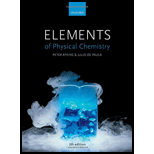
(a)
Interpretation:
The average dipole moment of 1,2-dichloroethane has to be determined if all the given three conformations are equal.
Concept Introduction:
Polar covalent bond involves an unequal sharing of electrons between two bonded atoms; it creates a partial separation of charge and a dipole moment.
Covalent bonds are polar, if there is a difference in electronegativity between the bonded atoms.
Calculation of the dipole moment of polyatomic molecules:
(a)
Explanation of Solution
The average dipole moment of the molecule can be calculated by the equation given below:
Given that the dipole moment of each
From the conformations, it is clear that conformation 2 is non polar and there will be no contribution to the mean dipole moment.
Thus, the mean dipole moment can be calculated by the below equation,
It can be rearranged as follows:
Therefore, the mean dipole moment is,
(b)
Interpretation:
The dipole moment of 1,2-dichloroethane has to be determined if all only second conformation exist.
Concept Introduction:
Polar covalent bond involves an unequal sharing of electrons between two bonded atoms; it creates a partial separation of charge and a dipole moment.
Covalent bonds are polar, if there is a difference in electronegativity between the bonded atoms.
Calculation of the dipole moment of polyatomic molecules:
(b)
Explanation of Solution
From the conformations, it is clear that conformation 2 is non polar and there will be no contribution to the mean dipole moment.
Therefore, the dipole moment will be zero for the compound, if only conformation 2 exist.
(c)
Interpretation:
The dipole moment of 1,2-dichloroethane has to be determined if the given conformations occur with probabilities in the ratio
Concept Introduction:
Polar covalent bond involves an unequal sharing of electrons between two bonded atoms; it creates a partial separation of charge and a dipole moment.
Covalent bonds are polar, if there is a difference in electronegativity between the bonded atoms.
Direction of dipole moment in a molecule is can be represented as follows,

(c)
Explanation of Solution
The average dipole moment of the molecule can be calculated by the equation given below:
Given the ratio for the conformation is
Thus, the mean dipole moment can be calculated by the below equation,
It can be rearranged as follows:
The mean dipole moment if the conformations are present in a ratio of
(d)
Interpretation:
The dipole moment of 1,2-dichloroethane has to be determined if the given conformations occur with probabilities in the ratio
Concept Introduction:
Polar covalent bond involves an unequal sharing of electrons between two bonded atoms; it creates a partial separation of charge and a dipole moment.
Covalent bonds are polar, if there is a difference in electronegativity between the bonded atoms.
Direction of dipole moment in a molecule is can be represented as follows,

(d)
Explanation of Solution
The average dipole moment of the molecule can be calculated by the equation given below:
Given the ratio for the conformation is
Thus, the mean dipole moment can be calculated by the below equation,
It can be rearranged as follows:
The mean dipole moment if the conformations are present in a ratio of
Want to see more full solutions like this?
Chapter 10 Solutions
Elements Of Physical Chemistry
- Calculate the pH and the pOH of each of the following solutions at 25 °C for which the substances ionize completely: (a) 0.200 M HClarrow_forwardCalculate the pH and the pOH of each of the following solutions at 25 °C for which the substances ionize completely: (a) 0.000259 M HClO4arrow_forwardWhat is the pH of a 1.0 L buffer made with 0.300 mol of HF (Ka = 6.8 × 10⁻⁴) and 0.200 mol of NaF to which 0.160 mol of NaOH were added?arrow_forward
- Determine if the following salt is neutral, acidic or basic. If acidic or basic, write the appropriate equilibrium equation for the acid or base that exists when the salt is dissolved in aqueous solution. If neutral, simply write only NR. Be sure to include the proper phases for all species within the reaction. NaN₃arrow_forwardCan I please get help with this?arrow_forwardCan I please get help with this?arrow_forward
- Use the Henderson-Hasselbalch equation to calculate pH of a buffer containing 0.050M benzoic acidand 0.150M sodium benzoate. The Ka of benzoic acid is 6.5 x 10-5arrow_forwardA. Draw the structure of each of the following alcohols. Then draw and name the product you would expect to produce by the oxidation of each. a. 4-Methyl-2-heptanol b. 3,4-Dimethyl-1-pentanol c. 4-Ethyl-2-heptanol d. 5,7-Dichloro-3-heptanolarrow_forwardWhat is the pH of a 1.0 L buffer made with 0.300 mol of HF (Ka = 6.8 × 10⁻⁴) and 0.200 mol of NaF to which 0.160 mol of NaOH were added?arrow_forward
- Can I please get help with this.arrow_forwardDetermine if the following salt is neutral, acidic or basic. If acidic or basic, write the appropriate equilibrium equation for the acid or base that exists when the salt is dissolved in aqueous solution. If neutral, simply write only NR. Be sure to include the proper phases for all species within the reaction. N₂H₅ClO₄arrow_forwardPlease help me with identifying these.arrow_forward
 ChemistryChemistryISBN:9781305957404Author:Steven S. Zumdahl, Susan A. Zumdahl, Donald J. DeCostePublisher:Cengage Learning
ChemistryChemistryISBN:9781305957404Author:Steven S. Zumdahl, Susan A. Zumdahl, Donald J. DeCostePublisher:Cengage Learning ChemistryChemistryISBN:9781259911156Author:Raymond Chang Dr., Jason Overby ProfessorPublisher:McGraw-Hill Education
ChemistryChemistryISBN:9781259911156Author:Raymond Chang Dr., Jason Overby ProfessorPublisher:McGraw-Hill Education Principles of Instrumental AnalysisChemistryISBN:9781305577213Author:Douglas A. Skoog, F. James Holler, Stanley R. CrouchPublisher:Cengage Learning
Principles of Instrumental AnalysisChemistryISBN:9781305577213Author:Douglas A. Skoog, F. James Holler, Stanley R. CrouchPublisher:Cengage Learning Organic ChemistryChemistryISBN:9780078021558Author:Janice Gorzynski Smith Dr.Publisher:McGraw-Hill Education
Organic ChemistryChemistryISBN:9780078021558Author:Janice Gorzynski Smith Dr.Publisher:McGraw-Hill Education Chemistry: Principles and ReactionsChemistryISBN:9781305079373Author:William L. Masterton, Cecile N. HurleyPublisher:Cengage Learning
Chemistry: Principles and ReactionsChemistryISBN:9781305079373Author:William L. Masterton, Cecile N. HurleyPublisher:Cengage Learning Elementary Principles of Chemical Processes, Bind...ChemistryISBN:9781118431221Author:Richard M. Felder, Ronald W. Rousseau, Lisa G. BullardPublisher:WILEY
Elementary Principles of Chemical Processes, Bind...ChemistryISBN:9781118431221Author:Richard M. Felder, Ronald W. Rousseau, Lisa G. BullardPublisher:WILEY





